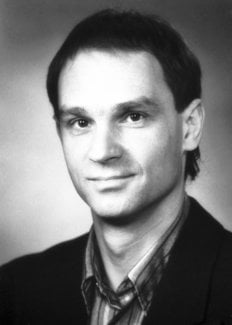Gerd Binnig
Biographical

I was born in Frankfurt, W. Germany, on 7.20., ’47 as the first of two sons. My childhood was very much influenced by the Second World War, which had only just ended. We children had great fun playing among the ruins of the demolished buildings, but naturally were too young to realize that much more than just buildings had been destroyed.
Until the age of 31, I lived partly in Frankfurt and partly in Offenbach, a nearby city. I attended school in both cities, and it was in Frankfurt that I started to study physics. Already as a child about 10 years of age, I had decided to become a physicist without actually knowing what it involved. While studying physics, I started to wonder whether I had really made the right choice. Especially theoretical physics seemed so technical, so relatively unphilosophical and unimaginative. In those years, I concentrated more on playing music with friends in a beat-band rather than on physics. My mother had introduced me to classical music very early in life, and I believe this played an important role in my subsequent development. Unfortunately, I started playing the violin rather late, at the age of 15 only, but thoroughly enjoyed being a member of our school orchestra. My brother was responsible for my transition from classics to beat by his perpetually immersing me with the sounds of the Beatles and the Rolling Stones, until I finally really liked that kind of music, and even started composing songs and playing in various beat-bands. In this way, I first learned how difficult teamwork can be, how much fun it is to be creative, and how unpredictable the reaction of an audience can be.
My education in physics gained some significance when I began my diploma work in Prof. Dr. W. Martienssen’s group, under Dr. E. Hoenig’s guidance. I realized that actually doing physics is much more enjoyable than just learning it. Maybe ‘doing it’ is the right way of learning, at least as far as I am concerned.
I have always been a great admirer of Prof. Martienssen, especially of his ability to grasp and state the essence of the scientific context of a problem. Dr. Hoenig introduced me to experimenting, and exhibited great patience when I asked him very stupid questions in trying to catch up on what I had missed over all the previous years.
In 1969, Lore Wagler became my wife. We had both been studying for quite a long time – Lore is now a psychologist – so only recently did we decide to have children: a daughter born in Switzerland in 1984, and a son born in California in 1986. This was the absolute highlight and most wonderful experience of my whole life. However, fatherhood is not without its sacrifice. For the time being, nearly all my hobbies, like music (singing, playing the guitar and the violin), and sports (soccer, tennis, skiing, sailing and playing golf) have had to take a back seat.
It was in 1978 that Lore – my private psychotherapist – convinced me to accept an offer from the IBM Zürich Research Laboratory to join a physics group. This turned out to be an extremely important decision, as it was here I met Heinrich Rohrer. His way of viewing physics, combined with his humanity and sense of humor, fully restored my somewhat lost curiosity in physics. My years at Ruschlikon, and in IBM Research in general, have been very exciting, not only because of the development of the STM, but also because of the stimulating and pleasant atmosphere created by the people working there, and by those responsible. Working together in a team with Heinrich Rohrer, Christoph Gerber and Edmund Weibel was an extraordinarily delightful experience, and one for which I shall be eternally grateful. It is also extremely gratifying that our work was recognized far afield. We were first awarded the German Physics Prize, the Otto Klung Prize, the Hewlett Packard Prize, the King Faisal Prize, and now the ultimate crown, the Nobel Prize for Physics. Life certainly does not become easier for a scientist once his work has exceeded a certain significance. But while prizes do add some complications, I must admit they also have their compensations!
(added in 1991:)
In 1990 I joined the Supervisory Board of the Daimler Benz Holding and presently I am involved in a few political activities.
This autobiography/biography was written at the time of the award and first published in the book series Les Prix Nobel. It was later edited and republished in Nobel Lectures. To cite this document, always state the source as shown above.
Nobel Prizes and laureates
Six prizes were awarded for achievements that have conferred the greatest benefit to humankind. The 12 laureates' work and discoveries range from proteins' structures and machine learning to fighting for a world free of nuclear weapons.
See them all presented here.
